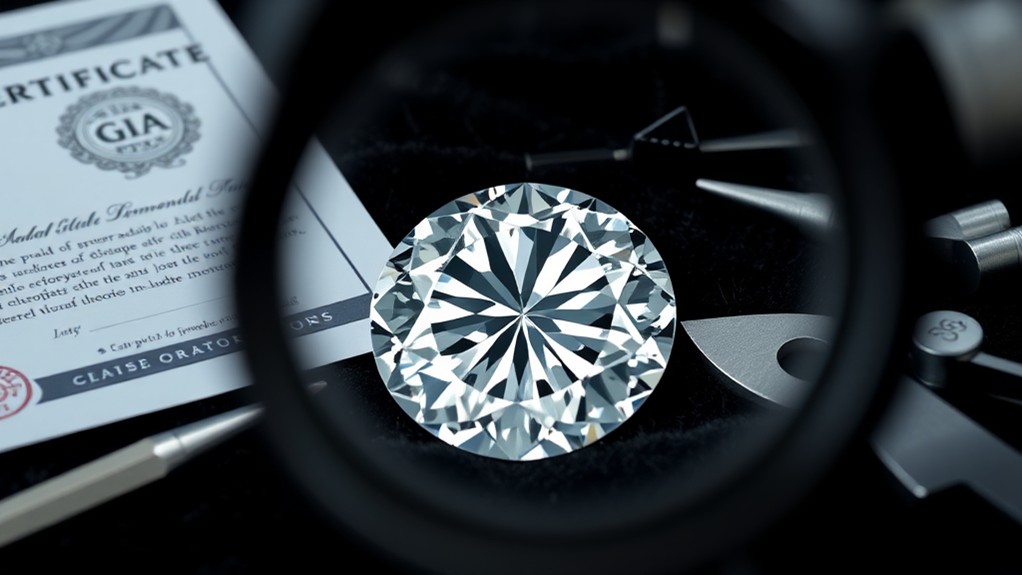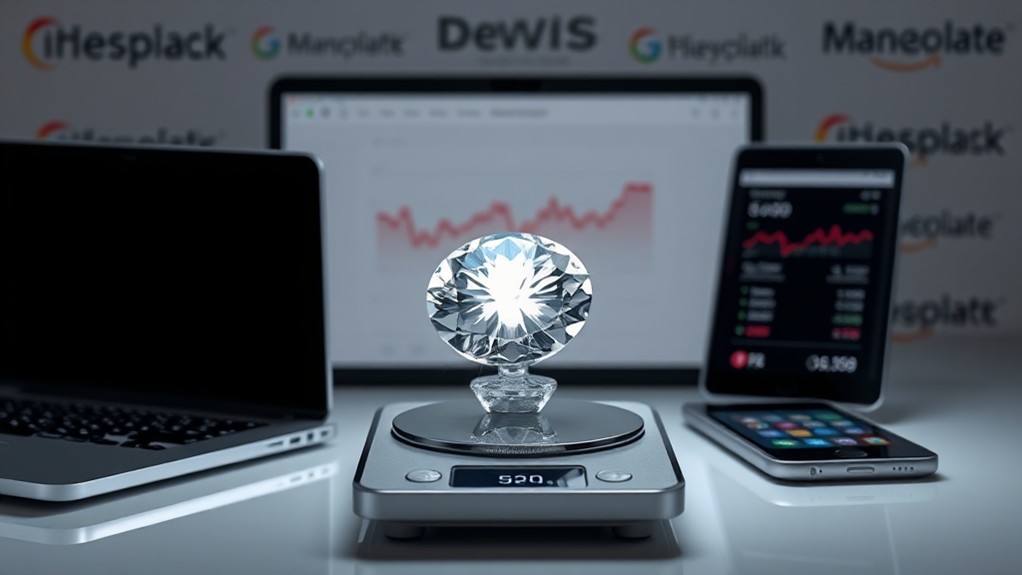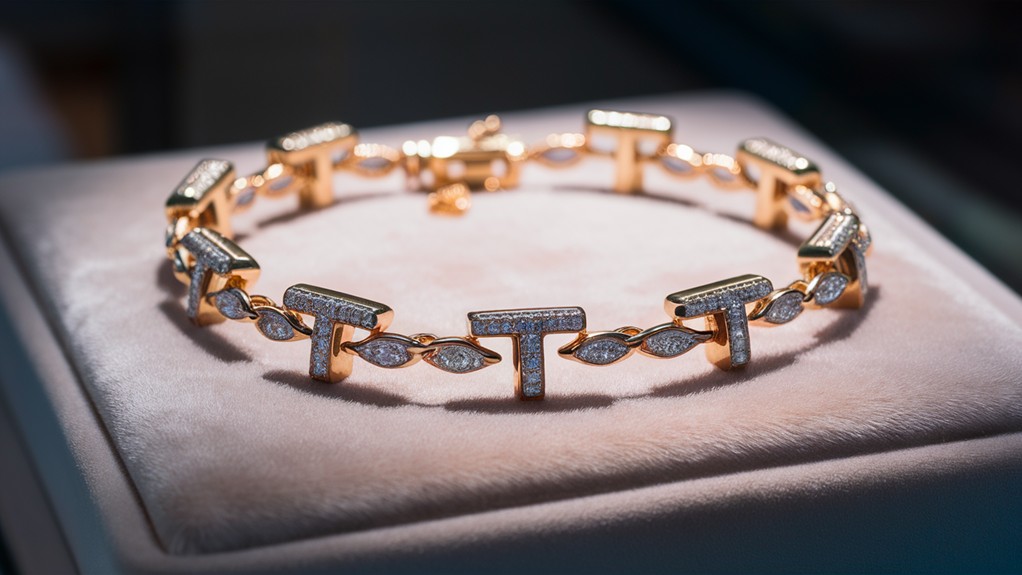If you're considering selling your GIA certified diamonds in 2024, you're in a prime position to optimize their value. The Gemological Institute of America's certification carries significant weight in the diamond market, offering assurance of quality and authenticity to potential buyers. However, maneuvering through the current market trends and understanding the factors that influence resale value can be challenging. You'll need to grasp the intricacies of the four Cs and develop effective pricing strategies to secure the best offers. But before you jump into the selling process, there's vital information you should know to guarantee you don't leave money on the table.
Our Highlighted Points
- GIA certification enhances resale value, typically offering 20-60% of original retail price for high-quality diamonds.
- Current market trends show 1-carat diamond prices range from $2,500 to $18,000, depending on quality factors.
- Online platforms and auctions often yield higher returns, potentially reaching 50-70% of retail value.
- Utilize the Rapaport Price List and independent appraisals to determine accurate pricing for your certified diamond.
- Highlight the four Cs (cut, color, clarity, carat) and GIA certification to attract buyers and justify pricing.
Understanding GIA Diamond Certification

Often misunderstood by newcomers to the diamond market, GIA certification is a fundamental aspect of selling high-quality diamonds. When you're dealing with GIA certified diamonds, you're handling stones that have undergone rigorous evaluation by the industry's most trusted authority.
The Gemological Institute of America (GIA) assesses diamond quality and value based on four significant factors:
- Cut
- Clarity grade
- Color grade
- Carat weight
These characteristics are meticulously documented in a detailed grading report, which accompanies each certified stone. This report serves as an unbiased assessment of the diamond's attributes, providing you with a powerful tool for determining its true worth.
GIA certification isn't just paperwork; it's a guarantee of authenticity and quality. Each certified diamond is inscribed with a unique serial number, allowing for easy verification against its certificate. This level of transparency and reliability is why GIA certified diamonds often command higher resale values and are preferred for investment purposes.
Understanding GIA certification is vital when selling diamonds, as it allows you to:
- Accurately price your stones
- Confidently discuss diamond characteristics with potential buyers
- Demonstrate the true value of your diamonds in a competitive market
Current Diamond Market Trends
Understanding GIA certification equips you with valuable knowledge, but staying informed about current market trends is just as essential when selling diamonds.
As of October 2024, diamond prices for 1 carat stones range from $2,500 to $18,000, with variations based on quality factors like cut, color, and clarity. The current market shows a slight decrease in prices, with natural diamonds dropping by -3.40% and lab-grown diamonds by -2.56% over the past month. Famous and rare diamond values, such as those for pink and blue diamonds, have remained relatively stable, with some even experiencing a slight increase in value. However, the overall trend in the diamond market suggests that prices are likely to continue fluctuating in the near future. Factors such as economic conditions, consumer demand, and global production levels all contribute to the dynamic nature of diamond prices.
When considering larger stones, be aware that 2 carat diamonds command a notable price jump, ranging from $8,500 to $59,000 because of their rarity.
It's vital to acknowledge that the resale value of diamonds typically averages about 50% of the lowest retail value, influenced by size, quality, and market demand.
To enhance your diamond's market value, consider these factors:
- Carat weight: Larger diamonds often fetch higher prices.
- Quality: Higher grades in cut, color, and clarity increase value.
- Current market trends: Stay updated on price fluctuations using resources like the Rapaport price list.
- Economic conditions: These can greatly impact diamond inventory and pricing.
Factors Affecting Resale Value

When you're looking to sell your GIA certified diamond, several key factors come into play that'll affect its resale value. The most fundamental aspects are the four Cs: cut, color, clarity, and carat weight. Higher quality in these attributes typically leads to better resale offers, with exceptional stones commanding premium prices.
GIA certification plays an essential role in determining resale value. This independent lab certificate boosts buyer confidence, often resulting in improved offers, particularly for high-quality diamonds.
It's vital to recognize that resale value generally ranges between 20-60% of the original retail price because of considerable markups in the diamond industry.
Market conditions and consumer demand greatly influence resale prices. Timing your sale can impact the value you'll receive, as diamond prices fluctuate based on economic factors and trends.
Furthermore, your chosen selling method affects potential returns:
- Direct sales to buyers or through auction sites often yield higher prices
- Selling to jewelry stores typically results in lower offers
To amplify your diamond's resale value:
- Maintain all original documentation, including the GIA certificate
- Research current market trends before selling
- Consider multiple selling options to find the best offer
Pricing Strategies for Sellers
Diamond sellers armed with a GIA certificate have a powerful tool for enhancing their profits. To optimize your pricing strategy for GIA certified diamonds, consider these key factors:
- Research current market trends to understand buyer preferences and demand.
- Utilize the Rapaport Price List for real-time valuations and competitive pricing.
- Assess your diamond's cut, color, clarity, and carat weight to determine its true value.
- Investigate different selling channels, including online platforms and direct sales.
- Time your sale according to market fluctuations and buyer interest.
When setting your price, aim for a resale value between 20-60% of the original retail price, depending on your diamond's characteristics.
Keep in mind that GIA certified diamonds typically command higher resale prices because of their recognized quality and legitimacy. To enhance returns, consider bypassing traditional jewelry stores in favor of online marketplaces or direct sales to consumers. These channels often offer better prices and greater flexibility.
As you develop your pricing strategy, be aware that the diamond market can be volatile. Stay informed about industry trends and be prepared to adjust your pricing accordingly.
Optimal Selling Platforms

Choosing the right platform to sell your GIA certified diamond can greatly impact your return on investment. When selling your diamond, consider these optimal selling platforms for optimal returns:
- Online platforms: Utilize reputable marketplaces that specialize in diamond resale opportunities. These sites often attract knowledgeable buyers, potentially yielding 50-70% of your diamond's retail value.
- Auction sites: For unique or high-quality GIA certified diamonds, auctions can generate competitive pricing through bidding wars. Be aware of associated fees that may affect your final profit.
- Direct sales: Marketing your diamond directly to consumers can result in the highest returns, often exceeding 60% of the original retail price. This approach requires more effort but can be highly rewarding.
- Consignment shops: These services can help you access a broader audience, potentially enhancing sale prices for certified diamonds. Factor in their fees when calculating potential profits.
- Jewelry stores: While typically offering lower returns (20-40% of retail price), they provide a quick and straightforward selling option.
To enhance your diamond's value, research each platform thoroughly, compare potential returns, and choose the option that best aligns with your selling goals and timeline.
Maximizing Returns on Certified Diamonds
Seeking to optimize returns on your GIA certified diamonds requires a strategic approach. To maximize your profits when buying and selling diamonds, consider the following key factors:
- Utilize online platforms and auction sites for better resale prices
- Monitor diamond price charts to time your sale effectively
- Obtain independent appraisals to determine current market value
- Focus on the diamond's specific attributes (4 Cs) to highlight quality
- Capitalize on the GIA certification to improve buyer confidence
The resale value of GIA certified diamonds typically ranges from 20% to 60% of their original retail price. Market demand plays a significant role in determining the final offer you'll receive.
To increase your chances of securing a higher price, consider selling through online platforms or auction sites, which often provide better returns compared to traditional jewelry stores.
Timing is vital when maximizing returns. Keep an eye on market trends and fluctuations in diamond prices to identify the optimal moment to list your diamonds for sale.
Furthermore, obtaining independent appraisals will help you understand your diamond's true worth, ensuring you receive competitive offers that reflect its current market value.
Frequently Asked Questions
What Is the Resale Value of Certified Diamonds?
You'll typically get 20-60% of the original retail price when reselling certified diamonds. The 4 Cs heavily influence value, and selling methods matter. Online platforms often offer better prices than traditional stores. Market conditions likewise impact resale value.
How Much Can You Sell a 1 Carat Diamond For?
You can typically sell a 1 carat diamond for $2,500 to $18,000, depending on its quality. For a good-quality stone, you're likely to get around $6,000. However, you'll usually only receive 20-60% of its original retail price.
Are Diamonds Worth More Now Than 40 Years Ago?
While diamond prices have generally increased over the past 40 years, you'll find their real value hasn't grown as much because of inflation. You'd likely have seen better returns investing in other assets like stocks during this period.
How Much Does a Diamond Cost in 2024?
In 2024, you'll find diamond prices vary widely. A 1-carat diamond can cost you between $2,500 and $18,000. You'll pay more for higher quality cuts, clarity, and color. Smaller diamonds are cheaper, while larger ones are considerably pricier.


